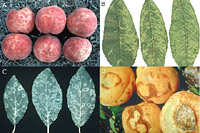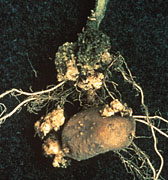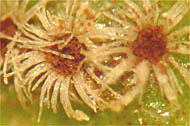By Kisha Shelton,
Plant Pathology Department, University of Georgia
Quarantine is a word that most people do not use on a daily basis. In fact, many people may think of the 1995 movie
Outbreak in which a town was
quarantined to prevent the spread of a human disease beyond the city limits. Quarantines also are used to prevent the spread of plant diseases. Two important plant diseases have been the subject of recent media reports because of their economic importance: plum pox and potato wart. But these are not the first plant diseases to be restricted by quarantines. In 1912, Congress passed the Plant Quarantine Act, to prohibit or restrict the entry of plants, plant products, soil, and other materials that may be carrying plant pathogens that are not known to be established in the United States from foreign countries.
The important question is a simple one. Are quarantines important? Most definitely quarantines are important. Diseases such as bacterial canker of citrus, chestnut blight, Dutch elm disease, and soybean cyst nematode were all introduced to the US from foreign countries. These pathogens resulted in some of the worst plant disease epidemics in American history. Bacterial canker of citrus has even been in the news again in the last few years ( see the January, 2000 News and Views in the archives ). It still causes much destruction to the Florida citrus industry and threatens other states that produce citrus if permitted to escape from Florida.
 |
Quarantines have been helpful for nearly 90 years in keeping the US free of exotic diseases, and the restrictions remain important. Plum pox is a virus disease that was first identified in Europe in 1915, and plant pathologists have identified more than 100 million European fruit trees with the disease. Plum pox may reduce yields by as much as 80-100% in susceptible cultivars. The plum pox virus has been kept out of the U.S. by a strict quarantine for almost 85 years, but in October, 1999, plum pox was found in Pennsylvania. How the pathogen was introduced into Pennsylvania is unknown. This is currently being investigated by the USDA. The virus is a threat to stone fruit trees (peaches, apricots, almonds). To prevent further spread in the US, portions of two counties in Pennsylvania were put under quarantine, meaning that it is illegal to move trees or budwood (used for propagation of new trees) in the genus Prunus out of the quarantined area. In addition, no new stone fruit trees susceptible to the virus may be planted until 2003. It has been estimated that production of stone fruits in the coming year in just those two Pennsylvania counties will be reduced by 230,000 bushels.
 |
|
More recently, the US has placed a quarantine on all potatoes grown in the Canadian province of Prince Edward Island (PEI). The quarantine was put into effect after just a few potatoes in one field on PEI were discovered to be infected with the potato wart pathogen (Synchytrium endobioticum). This pathogen is a funguslike organism that was eradicated from the US in 1982 after much work and expense. A reintroduction of this pathogen is feared because it could be devastating to the U. S. potato industry. Once introduced into soil, it is capable of surviving for up to 40 years. An agency of the USDA, the Animal and Plant Health Inspection Service (APHIS), has established strict policies restricting the movement of table stock potatoes from P.E.I. to the U. S. Table stock potatoes are the potatoes that are usually sold in grocery stores and used to make french fries. The USDA policies require that there can be no movement of seed potatoes (tuber pieces used for planting) from PEI to the US, that there must be phytosanitary certificates for seed potatoes (certifying that the potatoes are free of the disease), and that the origin of the table stock potatoes be certified. In this way, quarantines are being used by the USDA-APHIS to protect the important US potato industry.
So the next time you eat french fries, mashed or baked potatoes, or are enjoying a peach cobbler, it may remind you that quarantines help to keep agriculture and agricultural products safe. You can help protect US agriculture when you travel by cooperating with the Customs regulations concerning the import of fruits, vegetables, plant materials, and certain meat products. There is more more information about plum pox virus at the APHIS web site at www.aphis.usda.gov and in the APSnet Feature Plum Pox Potyvirus Disease of Stone Fruits.
For more information on the recent PEI potato wart disease outbreak and its impact on the US potato industry, see the ProMed news archive reports (NOTE: to go to the reports, type potato wart disease into the ProMED archives search box). The ProMed website describes both animal and plant disease outbreaks and quarantine activity around the world.
 |
Views: Cedar-apple rust.
This is a common fungal disease of red cedars (junipers) and apples (and crabapples) in North America and Europe. Cedar-apple rust is caused by a rust fungus that requires two hosts, apples and cedars, to complete its entire life cycle. In the spring, jelly-like orange horns form on small galls on the cedars and produce spores that can infect apples. Click image for an larger view, more information
|
